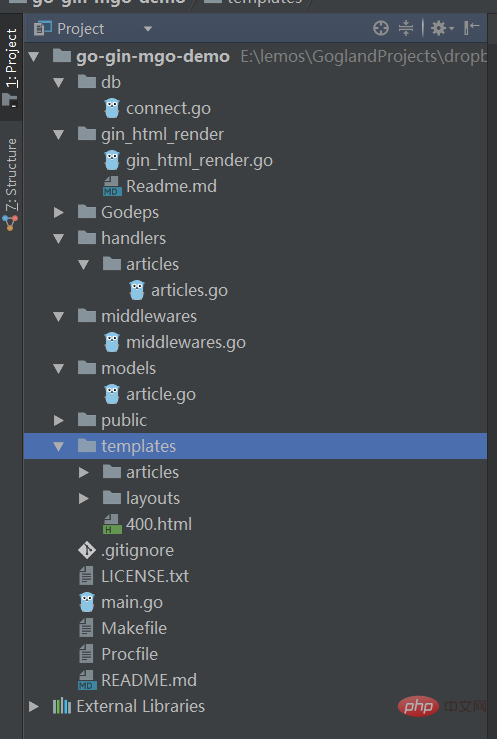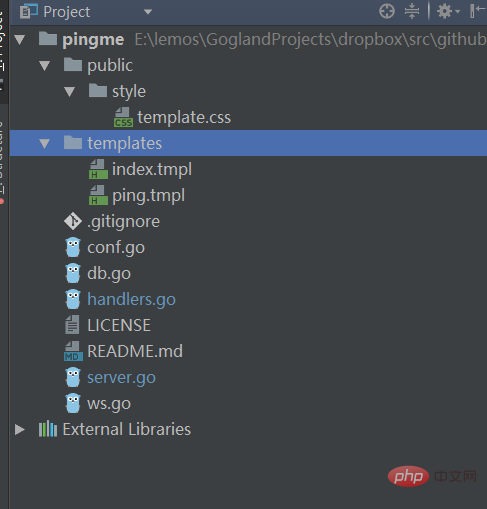

Encapsulation method 1. The routing is written in the main function, and the initial connection to the database is placed in the init() function. ,

First look at main.go
An initialization function to initialize db
func init() {
db.Connect()
}Second, routing
func main() {
// Configure
router := gin.Default()
// Set html render options
htmlRender := GinHTMLRender.New()
htmlRender.Debug = gin.IsDebugging()
htmlRender.Layout = "layouts/default"
// htmlRender.TemplatesDir = "templates/" // default
// htmlRender.Ext = ".html" // default
// Tell gin to use our html render
router.HTMLRender = htmlRender.Create()
router.RedirectTrailingSlash = true
router.RedirectFixedPath = true
// Middlewares
router.Use(middlewares.Connect)
router.Use(middlewares.ErrorHandler)
// Statics
router.Static("/public", "./public")
// Routes
router.GET("/", func(c *gin.Context) {
c.Redirect(http.StatusMovedPermanently, "/articles")
})
// Articles
router.GET("/new", articles.New)
router.GET("/articles/:_id", articles.Edit)
router.GET("/articles", articles.List)
router.POST("/articles", articles.Create)
router.POST("/articles/:_id", articles.Update)
router.POST("/delete/articles/:_id", articles.Delete)
// Start listening
port := Port
if len(os.Getenv("PORT")) > 0 {
port = os.Getenv("PORT")
}
router.Run(":" + port)
}Encapsulation method 2: Route and DB are individually encapsulated into a function, and the route is passed to another function in the form of parameters.

func SetUpServer() {
r := gin.Default()
// secret 相当于签名
store, _ := sessions.NewRedisStore(10, "tcp", CONFIG.Redis.Host, CONFIG.Redis.Password, []byte(CONFIG.Server.Secret))
r.Use(sessions.Sessions("session", store))
r.Use(gin.Recovery())
r.Use(Uniquify())
r.LoadHTMLGlob("templates/*")
r.Static("/static", "public/")
SetUpRoutes(r)
r.GET("/incr", func(c *gin.Context) {
c.JSON(200, gin.H{"count": c.MustGet("key").(string)})
})
// var port string
r.Run(":" + CONFIG.Server.Port)
}Encapsulation 3. Encapsulate routing, etc. into Server struct. For this, Server creates a new function, and routing and other related content are only included in the method.
type Server struct {
Ws *melody.Melody
Routes *gin.Engine
Games []*Game
}
func New() *Server {
ws := melody.New()
routes := gin.Default()
games := make([]*Game, 0)
return &Server{
Ws: ws,
Routes: routes,
Games: games,
}
}
...
...
func (srv *Server) RoutesInit() {
srv.Routes.GET("/jq.js", func(c *gin.Context) {
http.ServeFile(c.Writer, c.Request, "html/jq.js")
})
srv.Routes.GET("/goyaniv.js", func(c *gin.Context) {
http.ServeFile(c.Writer, c.Request, "html/goyaniv.js")
})
srv.Routes.GET("/game/:name", func(c *gin.Context) {
cookiekey, _ := c.Request.Cookie("goyanivkey")
cookieid, _ := c.Request.Cookie("goyanivid")
if cookieid == nil || cookiekey == nil {
cookieid := CreateCookie("goyanivkey", GenerateUnique())
cookiekey := CreateCookie("goyanivid", GenerateUnique())
http.SetCookie(c.Writer, cookieid)
http.SetCookie(c.Writer, cookiekey)
}
http.ServeFile(c.Writer, c.Request, "html/game.html")
})
srv.Routes.GET("/gamedev/:name", func(c *gin.Context) {
cookiekey, _ := c.Request.Cookie("goyanivkey")
cookieid, _ := c.Request.Cookie("goyanivid")
if cookieid == nil || cookiekey == nil {
cookieid := CreateCookie("goyanivkey", GenerateUnique())
cookiekey := CreateCookie("goyanivid", GenerateUnique())
http.SetCookie(c.Writer, cookieid)
http.SetCookie(c.Writer, cookiekey)
}
http.ServeFile(c.Writer, c.Request, "html/gamedev.html")
})
srv.Routes.GET("/game/:name/ws", func(c *gin.Context) {
srv.Ws.HandleRequest(c.Writer, c.Request)
})
srv.Routes.GET("/gamedev/:name/ws", func(c *gin.Context) {
srv.Ws.HandleRequest(c.Writer, c.Request)
})
srv.Ws.HandleMessage(func(s *melody.Session, msg []byte) {
FireMessage(srv, s, msg)
})
srv.Ws.HandleDisconnect(func(s *melody.Session) {
FireDisconnect(srv, s)
})
srv.Ws.HandleConnect(func(s *melody.Session) {
FireConnect(srv, s)
})
}
func (s *Server) Run() {
s.RoutesInit()
s.Routes.Run(":5000")
}For more golang knowledge, please pay attention to the golang tutorial column on the PHP Chinese website.
The above is the detailed content of How to encapsulate routing in golang. For more information, please follow other related articles on the PHP Chinese website!
 How to define variables in golang
How to define variables in golang
 What are the data conversion methods in golang?
What are the data conversion methods in golang?
 What are the commonly used libraries in golang?
What are the commonly used libraries in golang?
 What is the difference between golang and python
What is the difference between golang and python
 How to solve the problem that suddenly all folders cannot be opened in win10
How to solve the problem that suddenly all folders cannot be opened in win10
 mysql backup data method
mysql backup data method
 How to check website dead links
How to check website dead links
 Introduction to java access control modifiers
Introduction to java access control modifiers